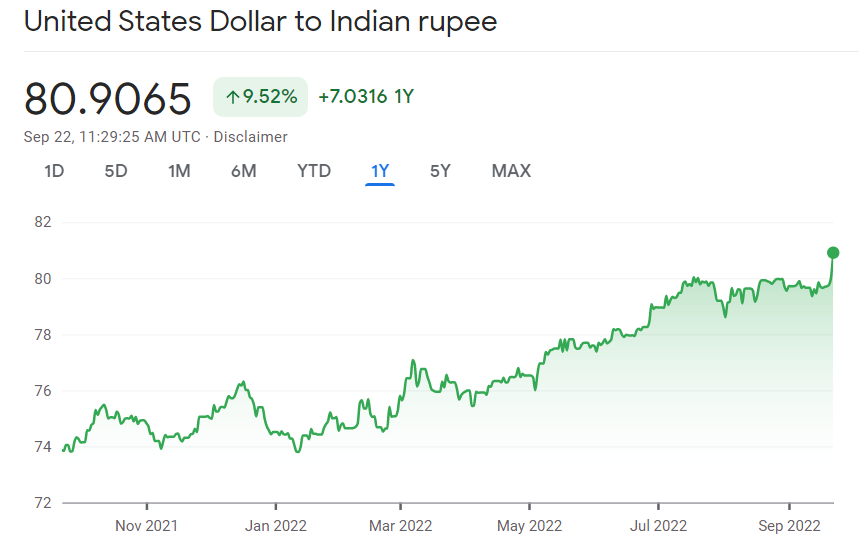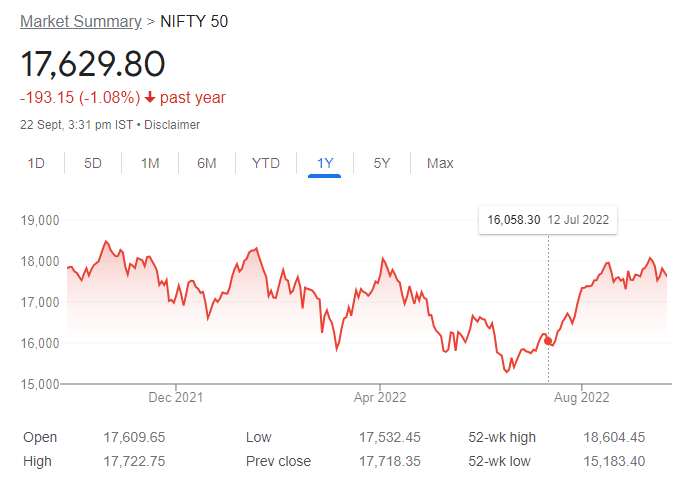Since the beginning of the Russia-Ukraine crisis, there has been a steady downward trend in the international currencies vis a vis the mighty US Dollar. Almost all currencies have depreciated against the USD – some more than the others – and the Indian Rupee (INR) is no exception. (Also Read: Cause and effect of Rupee Depreciation on Personal Finances)
This is because of the usual “Flight-or-Fight” response institutional investors have whenever faced with uncertainty. And, like most of the times in the past, they chose to flee to the safer markets. Now, whether you like it or not, the USD, despite all the shenanigans of the US Government and the Fed, is the world’s strongest currency because of its status as the reserve currency of the world.
There were shockwaves sent across the Indian financial sector and even the political class in mid-July when it was apparent that the USD could breach the INR 80 barrier. And that it did on July 20, 2022. Since then, the INR has covered some of the losses that were made and seemed to be finding its feet around this point.
One of the most talked about topics in this scenario is how the Indian economy and lower- and middle classes would suffer due to a higher import bill, especially the crude oil and imported coal. But an often-neglected aspect is how a depreciating rupee will affect the Non-Resident Indians or NRIs.
Is everything always about the USD?
Once again, as you may have seen in the above discussion as well, we have focused on the USD-INR exchange rate only. But India trades with many other countries and NRIs live in almost every country on the map. So, a generalization of the entire NRI community through a narrow lens would be a mistake.
But, to make the points simple, we will stick to the USD-INR exchange rate and try to find the answer to the question asked at the beginning- How NRIs could take advantage of the Depreciating Rupee? You can apply the same principles and arguments to GBP-INR, EUR-INR, or any other currency that you majorly deal in.
So, with that caveat aside, let us start discussing how you the NRI are affected when the INR depreciates against the currency in which you majorly deal.
Taking Advantage of the Rupee depreciation:
1. Your Remittances Mean More:
You went to a foreign country to earn more and leverage your skills to make a better living for yourself and your family back home. To this end, most likely you remit some amount regularly back to your NRI bank account (NRE or FCNR) maintained in India. Your family uses this money to pay for not only the essentials but also to climb up the social and economic ladder. (Read our detailed article on NRI Bank Accounts)
With a depreciating rupee (against your host currency), you may continue to send the same amount in USD, EUR, GBP, AED, SAR KWD, QAR, AUD, or SGD. But, with every fall in the INR value, your family will receive more rupees per dollar, pound, and so on.
2. Real Estate Investments Become More Attractive:
An NRI will generally find that the real estate prices in India depress with a depreciating rupee. It is because of the general inflationary expectations that come with a depreciating rupee. This generally curbs the investments in real estate by domestic investors and end-users.
Now, unlike Stock Markets which are more sensitive to news and numbers, Real estate takes time to show the real picture of the economy to the Investors. If the Inflationary situation persists for long, you will see demand going down and so will the prices. With inflation, the Purchasing and spending power reduce, the Cost of construction increases, and Interest rates rise which makes borrowing costlier…all these play their role in putting a brake on Real Estate Prices.
With a subdued real estate demand from local buyers, the real estate sellers – builders, housing societies, and brokers – offer better deals to the NRI investors as they are the ones with more money in a depreciating rupee market. So NRIs get the dual advantage of more INRs as well as better deals.
So, if you have a knack for Real estate Purchases in India, keep a watch on developments.
Also Check- 10 Reasons why Real Estate investment is riskier than equities?
3. Investments in Indian Equities for the Long-term:
NRIs can also increase their exposure to Indian equities (via mutual funds or directly) in times when the INR is falling. This is because, in a scenario where a local currency is falling, foreign investors flee the emerging markets and invest in the relatively safer markets, normally.
This also is due to other factors like Inflation and Interest rates in their home country. Foreign investors start selling their holdings in the Indian stock markets in a panic.
This may result in subdued growth in the stock market and more fearful investors around. In the last 1-year, Nifty 50 has delivered almost NIL Return (see the chart below).
As the best time to enter the stock markets is when there is a panic, NRIs can either start investing in great companies at bargain prices or can increase their exposure to them. (Also Read: Best Investment options for NRIs in India)
This again will result in a manifold benefit to the NRI investors:
- First, they will be able to invest more in rupee terms.
- Second, they will get great companies at attractive valuations.
- Third, as the uncertainty around global crises comes to an end (even if the crises are still ongoing like the Russia-Ukraine conflict or the COVID pandemic in most of 2021) the markets find their way up. This may result in handsome gains in a short span.
- Fourth, tomorrow if the INR appreciates, that will be an additional benefit when you repatriate your money.
- Finally, long-term investors can build their portfolio with buy-and-hold types of stocks and can average down the costs of investments.
4. Better Interest Yields:
With a depreciating rupee, the bond markets also become tighter as banks and corporates find it challenging to raise funds. This happens because the Reserve Bank of India (RBI) generally increases the benchmark rates to stave off the imported inflationary expectations which are a result of a fall in the INR. (Aso Read: How RBI manages inflation and growth in the economy?)
Therefore, in order to keep their liquidity intact, the banks, NBFCS (Non-Banking Finance Companies), and corporates also offer higher interest rates.
This presents another avenue of increased interest incomes for NRIs who are risk-averse and probably either have too many Illiquid assets like property or may want to park money for the short to medium term.
Conclusion:
Imagine an NRI who is currently living in the US and who has taken a home loan in India. if the EMI of the home loan is Rs. 40,000 then at a USD-INR exchange rate of Rs. 75 s/he must remit USD 533.33; $512.82 at Rs. 78; and at Rs. 80 only $500.
The extra savings, whether you decide to keep them in your country of residence or remit them to your Indian account, are going to have a positive and uplifting effect.
Though a steeply falling rupee is a nightmare condition for a net-importer country like India, for a large chunk of NRIs it is a windfall.
With the current crises far from resolving and new crises emerging in geo-political, international, health, as well as trade spheres, the fall in the price of the INR against some of the major currencies may continue. Therefore, better take note of your financials and plan investments accordingly, so as to take benefit of this situation.









 Manikaran Singal is the founder and Chief financial planner at Good Moneying Financial Solutions. He is a CERTIFIED FINANCIAL PLANNER CM and SEBI registered Investment adviser (Regd no. INA 100001620). He’s having 20+ years of experience in financial services space.
Manikaran Singal is the founder and Chief financial planner at Good Moneying Financial Solutions. He is a CERTIFIED FINANCIAL PLANNER CM and SEBI registered Investment adviser (Regd no. INA 100001620). He’s having 20+ years of experience in financial services space.

